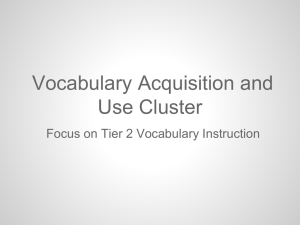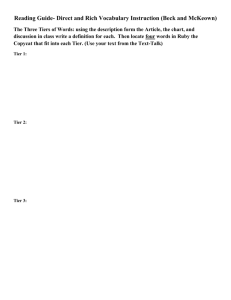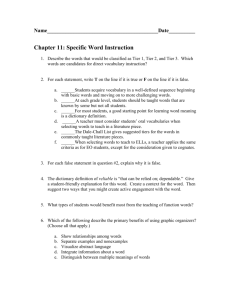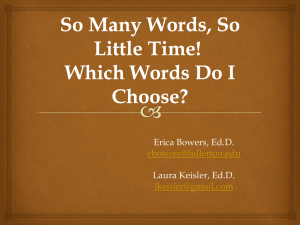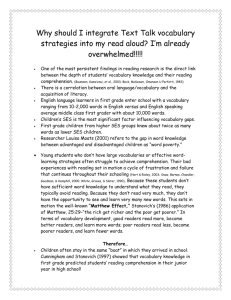Teaching Vocabulary to ALL Your K-3 Students
advertisement
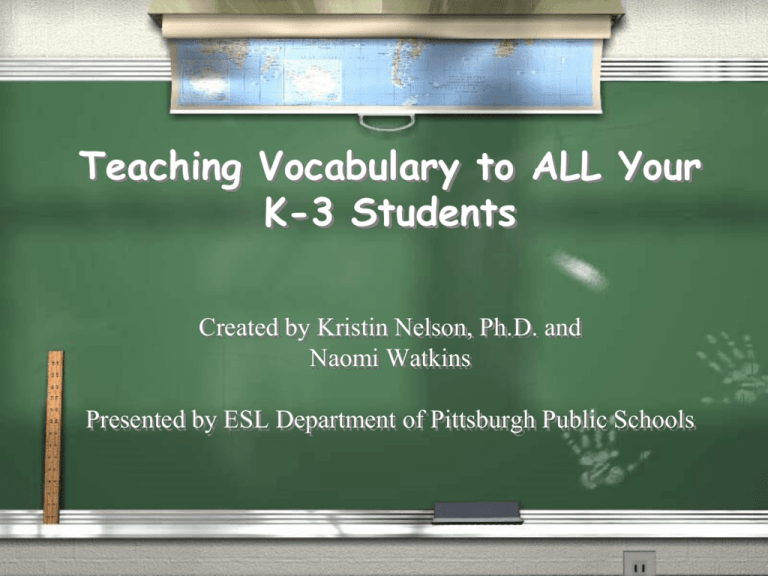
Teaching Vocabulary to ALL Your K-3 Students Created by Kristin Nelson, Ph.D. and Naomi Watkins Presented by ESL Department of Pittsburgh Public Schools Today’s Schedule Vocabulary Instruction Self-Inventory Why K-3 Vocabulary? What do mean by ALL Students? What Research Says About K-3 Instruction Comprehensive Vocabulary Curriculum Specific-Word Instruction Word-Learning Strategies Word Consciousness Vocabulary Instruction Self-Inventory Take a few minutes to reflect on the vocabulary instruction in your classroom. What do you do? What are your feelings? Then, discuss your responses with a neighbor. Then, we’ll discuss as a group. Why K-3 Vocabulary? • Word knowledge gap begins before school Hart and Risely (1995) found that 3-year-olds from advantaged homes had oral vocabularies 5x larger than those from high-poverty homes Without intervention, vocabulary gap gets bigger To catch up, low-vocabulary students would need to learn 10 words a week. Biemiller (2005) believes the bottom 25% begin kindergarten with 1,000 fewer root word meanings. Why K-3 Vocabulary? Grade End of Pre -K End of K End of Grade 1 End of Grade 2 Average Student (at 2.4 root Bottom 25% ( at 1.6 root words per day) words per day) 3,440 2, 440 4,300 3, 016 5,160 3, 592 6,020 4, 168 Table fr om Vocabulary Handbook, p.9 What We Mean By ALL Students Gifted students Average students English Language Learners Struggling Readers SPED students Related Research Repeated Reading Rich Instruction ELLs SPED Students Observations Repeated Readings Research shows that encouraging vocabulary acquisition in the primary grades using repeated reading combined with word meaning explanation works. In recent studies, Biemiller and Boote (2006) showed, in K-2 settings with 50% Englishlanguage learners, that repeated reading with repeated word explanations, students acquired up to 41% of words taught. Repeated Readings cont. In these Biemiller studies, instruction was in the form of providing simple explanations. At the 41% rate of acquisition, 1,000 word meanings, 25 per week, would have to be taught to learn 400 words a year. Kindergarteners benefited from more than two readings with word explanation--1st and 2nd graders, twice was sufficient. Rich Instruction In recent studies, Beck and McKeown (2007) showed that kindergarten and first-grade children from a low-achieving school learned more sophisticated words with 6 days of rich vocabulary instruction versus 3 days--with a mean gain of 8.17 words for the verbal task (vs. 2.50) and 8.03 (vs. 2.97) for the picture task. Observations Nelson, Dole, Hosp & Hosp (2008) showed that over a three-year period, K-3 teachers in a reading reform project, taught vocabulary on average about 8 minutes a day. Is this enough? English Language Learners From the research we have, the same research-based strategies also are effective with ELLs, but should be modified (Calderon et al. 2005). Vocabulary Instruction for ELLs Considerations: Need to teach Tier I words (basic) August et al. (2005) Place words in context Provide additional scaffolding and exposures Tie words to students’ cultural background Build background knowledge vs. merely activating BK Use cognates Incorporate pictures, objects, gestures, etc. SPED Students Studies show that the same researchbased strategies also are effective with students with disabilities--but may need to be taught with more intensity and repetition Research Suggests A Comprehensive Vocabulary Curriculum Includes: Specific-Word Instruction Word-Learning Strategies Fostering Word Consciousness What is Specific-Word Instruction? Step 1: Selecting Words to Teach Step 2: Deciding to what depth you want students to know these words Step 3: Determining methods to teach words at determined depth Rationale for Selecting Words Text may contain too many unknown words for direct instruction Word meanings may be given within the text as they occur Excellent instruction would be difficult to provide for a long list of words Issues Related to Choosing Words There is no agreed upon list of best individual words to teach No definitive method for approaching the issue how to choose words Choices may vary depending on grade level, reading ability, English proficiency Choosing Specific Words: Possible Approaches Biemiller (2001) argues for teaching 4,000 root words by the end of grade 2 followed by 500 to 750 roots per year in elementary schools. He and his colleagues are working on a sequential list for teachers. Relying on recommendations from basals (but some such as Hiebert (2004) argue these words are often too rare to spend valuable time teaching) They sometimes may be too easy as well. Possible Approaches cont. Teach a group of words that have related meanings or related to a single topic Teach words that are important to the understanding of selection or because of their general usefulness Teach words that are “conceptually difficult” (i.e., not part of everyday experiences) such as superconductor as opposed to superfluous Nagy (1988) Possible Approaches cont. Teach words teachers want to be incorporated into their writing or speaking Duin and Graves (1987) Teach words based on a three-tiered approach Beck, McKeown, & Kucan (2002) Developed through their research Three-Tiered Approach Tier One words: Most basic words, rarely requiring instruction in school. Baby, clock, glue, sad Tier Three words: Words whose frequency of use is quite low, often being limited to specific domains, and probably best learned when needed in a content area. Isotope, lathe, peninsula Tier Two words: High-frequency words for mature language users; instruction in these words can add productively to an individual’s language ability. Coincidence, absurd, industrious Beck, McKeown, & Kucan, 2002 Criteria for Identifying Tier Two Words Importance and Utility: Words that are characteristic of mature language users and appear frequently across a variety of domains. Instructional Potential: Words that can be worked with in a variety of ways so that students can build rich representation of them and of their connections to other words and concepts. Conceptual Understanding: Words for which students understand the general concept but provide precision and specificity in describing the concept. Beck, McKeown, & Kucan, 2002 How to Choose Tier Two Words List all the words that are likely to be unfamiliar to your students Analyze your list: Which are Tier Two words? Which are most necessary for comprehension? Which will you teach? In-brief or in-depth? Beck, McKeown, & Kucan, 2002 Chapter Two, Bringing Words to Life Choosing Tier Two Words Group Activity Choosing Tier Two Words: A Model Read Go Owen and Mzee through the process just described and then Make a list of 4-5 words from the text that you would teach. Compare/discuss lists as a group Some Good Choices From Owen & Mzee: wallowed, grazing, surging, sanctuary, nuzzles, commotion, affection, resilience, extraordinary What additional words might you select for ELL, Struggling and SPED students? Step Two: Deciding to What Depth You Want Students to Know Words Do you want students to: Simply be able to recognize the word? Know the multiple meanings of the word? Understand the word while reading within the context of the text? Use the word in a different context? Use the word in oral conversation? Incorporate the word in their writing? If you want students to understand words at a deeper level, then… Provide lots of examples Relate words to students’ prior knowledge Elaborate on the meanings of the words Present contrasting words It’s like this, it’s not like that Provide lots of repetition of the words Use gestures, pictures, visuals, etc. to help convey the meanings of words Teach the word conceptually Relate the word to other related words that students already know Repeatedly expose students to the words in different contexts A Few Methods for Teaching Specific Words at a Deep Level Use conceptual approaches to teaching vocabulary such as: 1. 2. 3. 4. 5. 6. Text Talk Concept Picture Sort Semantic feature analysis Vocabulary Pictures Vocabulary Boxes Word Squares Demonstration of Text Talk With Make Way for Ducklings Beck et al’s Basic Text Talk Instructions 1. 2. 3. 4. 5. 6. Read the story. Conceptualize the word within the story. Have children say the word. Provide a student-friendly definition. Engage them in activities using the word. Have children say the word. Specific Word Centers Center Reflection: Think-Pair-Share Consider the following questions individually: 1. 2. 3. 4. With what activities were you already familiar? Unfamiliar? How did the activities enrich your understanding of specific words? What aspects of these activities do you think your students may find challenging? How can you help your students overcome these challenges? What adaptations might you have to make? How can you incorporate these activities into your classroom? Then, turn to a neighbor and share your responses. Word-Learning Strategies Word-part Prefixes, Context K: clues: Suffixes, & Affixes clues Model using context clues through thinkalouds 1-2: Instruct students how to use context clues 3+: Teach the different types of context clues Some Methods for Teaching Students Word-Learning Strategies Concept-Definition Map Word-Part Clue Evaluation Word Part Web Memory Word Families Prefix Crossword Word-Learning Strategies Centers Word-Learning Strategies Center Reflection: Think-Pair-Share Consider the following questions individually: 1. With what activities were you already familiar? Unfamiliar? 2. How did the activities enrich your understanding of how to learn words on your own? 3. What aspects of these activities do you think your students may find challenging? How can you help your students overcome these challenges? What adaptations might you have to make? 4. How can you incorporate these activities into your classroom? Then, turn to a neighbor and share your responses. Teaching Word-Consciousness Word games Play -riddles, rhymes and Word Histories and Origins - Latin, French, Spanish connections Idioms, Similes and Metaphors Example of Word-Consciousness “Teacher hands out little books called, Dinosaur Riddles. T has students read the riddles to themselves and then asks for students to guess the answers. Teacher explains to students why the riddles are funny. Example: What do you call a dinosaur that smashes everything in its path? Tyrannosaurus Wrecks.” Other Ideas for Fostering Word Consciousness Word Wizard: bringing in examples from home of words taught at school Use sophisticated words in the classroom “It was magnanimous of your mom to send in these cupcakes” Share favorite words with each other - “My favorite word is epiphany, or serendipity…because…it means…and it sounds so pretty…” Point out interesting language in stories students write - “Those were great words…” Or in stories you read to them ”It was fun to read the words …the author included in her story.” Play games such as Scrabble and crossword puzzles Read and write riddles (maybe with themes such as dinosaurs, Halloween, pets) Explain and use figures of speech “She’s as happy as a clam” “Tough as nails” Read and write poetry Ideas for Fostering Word Consciousness? What do you already do in your classrooms? Let’s brainstorm ideas. A Review of What a Vocabulary Classroom Includes: Student-friendly definition Compare and contrast Elaboration Gestures Real, concrete objects/hands-on experiences Teacher examples Student examples Repetition Connections to students’ experiences Fun with words Conclusions What will you try to incorporate/implement in your practice? What challenges do you foresee regarding this implementation? About what do you still have questions? Kristin Contact Information Nelson: kristinnelson4@comcast.net Naomi Watkins: naomiwatkins@gmail.com University of Utah 1705 E. Central Campus Dr. Room 142 Salt Lake City, UT 84112 If you don’t mind, we would greatly appreciate if you left us with your completed self-inventories.

